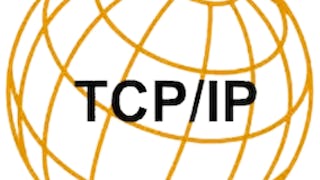Master the fundamental protocols and technologies that power the modern internet with this comprehensive TCP/IP and Internet course. Designed for aspiring network professionals and IT specialists, this course takes you through the complete networking stack—from physical layer transmission to application layer protocols. You'll gain hands-on experience with transport protocols like TCP and UDP, explore network layer routing and IP addressing, and understand how data securely traverses the internet infrastructure. Through practical examples and real-world scenarios, you'll learn network architecture design, multimedia transmission, wireless networking, and essential security protocols. This course bridges theoretical computer networking concepts with practical implementation skills, preparing you to design, deploy, troubleshoot, and secure modern network systems across enterprise and cloud environments. Whether you're pursuing a career in network engineering, cybersecurity, or cloud computing, this course provides the foundational knowledge needed to excel in today's interconnected digital landscape.

Enjoy unlimited growth with a year of Coursera Plus for $199 (regularly $399). Save now.

Recommended experience
What you'll learn
Understand TCP/IP architecture, protocols, and layered networking principles, ensuring efficient and secure communication.
Analyse packet transmission, routing, congestion control, and network security challenges for optimised data flow.
Gain hands-on experience with Wireshark for packet analysis and develop network applications using socket programming.
Design, configure, and troubleshoot enterprise networks while applying security protocols to protect real-world systems.
Skills you'll gain
Details to know

Add to your LinkedIn profile
November 2025
See how employees at top companies are mastering in-demand skills

There are 10 modules in this course
In this module, we get an overview of current computer networks and the internet, their evolution and their uses, before getting to know what a protocol is and why we need it in the context of a network. With a basic understanding of what a network and a protocol are, we then focus on learning the involvement of different entities, like the edge, access networks, and the core side. We then move on to learn the key characteristics which influence the network performance, including throughput and delay at various network entities. We conclude the module by describing the layered architecture by taking the Open Systems Interconnections (OSI) and TCP/IP models of layers and comparing them.
What's included
17 videos15 readings15 assignments
In this module, we discuss the key principles of network applications, including client-server architecture and comparing it with peer-peer architecture, processes in the scope of an application, and creating network application programs with the help of a socket interface. We then move on to know what is World Wide Web (WWW), before learning the key application layer protocol behind the working of today’s Internet. i.e., HTTP in depth. Further, we will discuss the Domain Name System (DNS) in detail, including its role in today’s internet, its working in two different flavours, records, and messages used for DNS services. We conclude the module by describing what is Email, its message components, and which protocols have made today’s Email work realistically.
What's included
16 videos15 readings16 assignments
In this module, we discuss the working of major transport layer protocols namely, User Datagram Protocol (UDP) and Transport Control Protocol (TCP) in detail. At first, the multiplexing and demultiplexing of UDP and TCP are detailed with the help of their respective header formats. Next, the working of reliable data transfer and functioning of flow control in TCP are described in detail before presenting its connection management where TCP’s connection establishment and termination process are explained. The module then brings in the principles of congestion control and explains the different approaches by TCP for congestion control. Finally, the module concludes by comparing the UDP and TCP applications by discussing their respective pros and cons.
What's included
20 videos19 readings19 assignments
This module focuses on introducing the network layer by defining the services provided by this layer and discussing packet switching, including the datagram approach and network-layer performance. Then we'll look into the details of Internet Protocol version 4 (IPv4), including addressing, packet format, options, ICMPv4, mobile IP and then finally IP version 6.
What's included
16 videos15 readings17 assignments
This module focuses on understanding how a router has a forwarding table to forward a packet to the appropriate next node on its way to the final destination or destinations. To make the forwarding tables of the router, the Internet needs routing protocols that will be active all the time in the background and update the forwarding tables. We’ll look into the details of the network layer decomposed into two interacting parts, the data plane and the control plane. We then move on to learn the concept of Multicasting and the SDN approach.
What's included
14 videos14 readings16 assignments
This module focuses on understanding how different integrated media, such as text, images, audio, and video, are generated, stored, and transmitted digitally and can be accessed interactively. The module covers subjects that are, directly or indirectly, related to multimedia, such as compression and digitising multimedia data. Then we'll look into the details of multimedia protocols and protocols for real-time conversational applications.
What's included
13 videos12 readings14 assignments
In this module, we learn the role and functioning of the link layer. Precisely, how the link layer contributes to error detection and correction of data, three different mechanisms of coordinating the multiple access problem at the link layer and finally the working of Ethernet, the most widely used LAN technology.
What's included
19 videos18 readings20 assignments
This module focuses on understanding how data and signals can be both analogue and digital along with their characteristics. Concentrate on how to convert digital data to digital signals and then convert analogue data to digital signals. Covers on multiplexing to benefit more from the bandwidth available. Then will discuss the transmission media that are used in data communication along with wireless and mobile networks.
What's included
13 videos12 readings14 assignments
In this module, we understand the network management in depth. Specifically, we learn the key functionalities of network management including Fault, Configuration, Accounting, Performance, and Security (FCAPS) management aspects. Once the key functions are studied, we move on to learn the workings of Simple Network Management Protocol (SNMP) in depth. Here, we focus on understanding SNMP framework, operations, and its significance in network monitoring and management. We conclude the module, by learning the role of NETCONF and YANG in the overall.
What's included
17 videos16 readings18 assignments
In this module, we first discuss the key principles of securing network applications before moving on to know what Transport Layer Security (TLS) is and its contribution to securing HTTP applications. Precisely, we will learn the working of TLS with respect to connection establishment, handshaking, key derivation and safe data transfer. We conclude the module by understanding how the security of Email communication is achieved, and also the role of firewalls and Intrusion Detection Systems (IDS) in aiding operational security.
What's included
16 videos16 readings17 assignments
Instructor

Explore more from Computer Security and Networks
 Status: Free Trial
Status: Free Trial Status: Free Trial
Status: Free TrialUniversity of Colorado System
 Status: Preview
Status: PreviewYonsei University
 Status: Free Trial
Status: Free Trial
Why people choose Coursera for their career





Open new doors with Coursera Plus
Unlimited access to 10,000+ world-class courses, hands-on projects, and job-ready certificate programs - all included in your subscription
Advance your career with an online degree
Earn a degree from world-class universities - 100% online
Join over 3,400 global companies that choose Coursera for Business
Upskill your employees to excel in the digital economy
Frequently asked questions
To access the course materials, assignments and to earn a Certificate, you will need to purchase the Certificate experience when you enroll in a course. You can try a Free Trial instead, or apply for Financial Aid. The course may offer 'Full Course, No Certificate' instead. This option lets you see all course materials, submit required assessments, and get a final grade. This also means that you will not be able to purchase a Certificate experience.
When you enroll in the course, you get access to all of the courses in the Specialization, and you earn a certificate when you complete the work. Your electronic Certificate will be added to your Accomplishments page - from there, you can print your Certificate or add it to your LinkedIn profile.
Yes. In select learning programs, you can apply for financial aid or a scholarship if you can’t afford the enrollment fee. If fin aid or scholarship is available for your learning program selection, you’ll find a link to apply on the description page.
More questions
Financial aid available,
¹ Some assignments in this course are AI-graded. For these assignments, your data will be used in accordance with Coursera's Privacy Notice.

